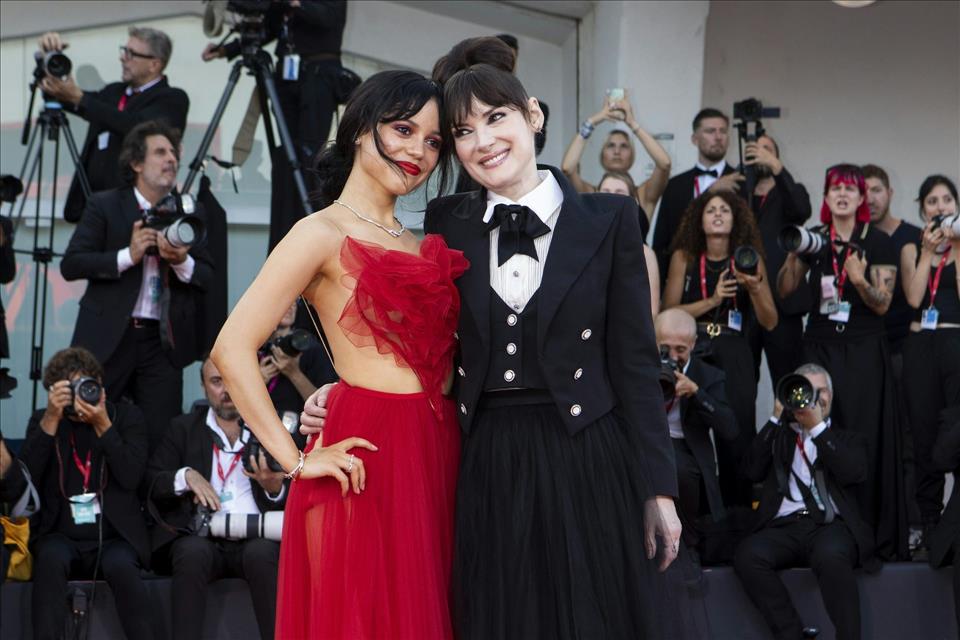
Beetlejuice Beetlejuice Celebrates The Enduring Appeal Of Being A Goth Girl And Introduces The Goth Mum
As one of the first overtly goth characters to appear in a mainstream film, Lydia Deetz's style had a huge impact on alternative teens in the late 1980s. Beetlejuice was released the same year as another goth horror comedy – Elvira, Mistress of the Dark. Compared with Cassandra Peterson's equally iconic but outrageously sexual gothic vamp, Lydia was an attainable role model. She was the goth next-door: cute, stylish, sympathetic and not overtly sexualised.
Every element of Lydia's look was memorable: the spiky fringe, the backcombed up-do, the giant broad-brimmed black sunhat, the black mourning veil, the red tulle wedding dress, the SLR camera as accessory.
Costume designer Aggie Guerard Rodgers was influenced by goth subcultural style of the time but added twists so that the look felt“strange and unusual”, to paraphrase Lydia herself. Ryder went on to have a career defined by edgy, gothic-tinged roles and, in her early 1990s relationship with actor Johnny Depp, a reputation as one half of the ultimate goth celebrity couple.
The history of the goth girlSince Beetlejuice, the goth girl has become a pervasive figure in popular culture. She appears particularly frequently in comics and animation. The character Death from Neil Gaiman's The Sandman (recently brought to life by Kirby Howell-Baptiste in Netflix's TV adaptation) was an early version. Goth girls are ubiquitous in manga and anime. There was even an animated TV spin-off of Beetlejuice focusing on Lydia in the 1990s.
The goth girl's ancestors are the heroines of 18th and 19th-century gothic novels, who are characteristically on the cusp between childhood and adulthood. Characters such as Emily St Aubert from Ann Radcliffe's The Mysteries of Udolpho (1794) live in gloomy, often haunted castles and are artistic, sensitive – and prone to a wild imagination.
Ryder and Ortega as mother and daughter in Beetlejuice Beetlejuice. Warner Bros
Jane Austen's Northanger Abbey (written in 1803 and published in 1817) parodies Radcliffe through heroine Catherine Morland, who is perfectly ordinary but imagines herself to be living in a gothic novel. Similarly, Lydia melodramatically declares:“My whole life is one big, dark room.” The twist is that Lydia's house really is haunted.
Contemporary representations of goth girls tend to combine the cute or whimsical with the gloomy and macabre. They challenge or satirise stereotypical ideas of cuteness by merging it with horror imagery, or alternatively, defuse horror through whimsical humour.
Goth girls are appealing to many young women because they simultaneously conform to and refuse conventional femininity. This makes them a powerful model for negotiating the teenage years. In a world where pink is ubiquitous, it can be empowering to choose black.
Representation for goth mumsWhat few of these examples show, however, is what happens when goth girls grow up. The stories of most gothic heroines end with marriage or death, or in the case of comics and animated series, they stay conveniently forever young.
Beetlejuice Beetlejuice departs from convention by showing two generations of goth women. Lydia is now the host of a paranormal talk show in the vein of Most Haunted, and mother to sulky, rebellious teen daughter Astrid, played by Ortega.
In terms of her goth credentials, Ortega is to Gen Z what Ryder was to Gen X. As the star of Netflix's Wednesday (2022), a reimagining of the character from The Addams Family, Ortega is the perfect goth girl for the 2020s. Off screen, the fashion media celebrates Ortega's “goth-glam” style, which wittily combines designer labels with a gothic sensibility.
Winona Ryder in the original Beetlejuice film. Landmark Media/Alamy Stock Photo
Framed by social media culture, Ortega goes much further than 1990s stars such as Ryder or Christina Ricci (the 1990s incarnation of Wednesday Addams) ever did in consciously constructing a goth girl identity as a kind of personal brand.
The generation that first loved Ryder and Ricci, however, are not done with their goth heroines. Sociologist Paul Hodkinson has shown that many of the original goths of the 1980s and 90s have chosen to age within their subculture.
He surveyed attendees of the Whitby Goth Weekend in 2010 and discovered that many had married and begun families while maintaining – in modified form to accommodate careers, parenthood and ageing bodies – the style, music taste and leisure activities with which they built their identities.
Winona Ryder as the older Lydia Deetz in Beetlejuice Beetlejuice represents these ageing goth parents. The goth mum – the goth girl who grew up – is a character we have not seen on screen in quite this way before.
The older Lydia wears a modified goth style, recognisably still hers but adapted to adulthood. She finds herself reconciled with her egotistical artist stepmother Delia, played by Catherine O'Hara. This is a film that centres female relationships.
You can work things out with your parents, and still wear goth clothes, the film seems to tell us. Forget the Addamses – this is what a goth family looks like.
Looking for something good? Cut through the noise with a carefully curated selection of the latest releases, live events and exhibitions, straight to your inbox every fortnight, on Fridays. Sign up here .

Legal Disclaimer:
MENAFN provides the
information “as is” without warranty of any kind. We do not accept
any responsibility or liability for the accuracy, content, images,
videos, licenses, completeness, legality, or reliability of the information
contained in this article. If you have any complaints or copyright
issues related to this article, kindly contact the provider above.


















Comments
No comment